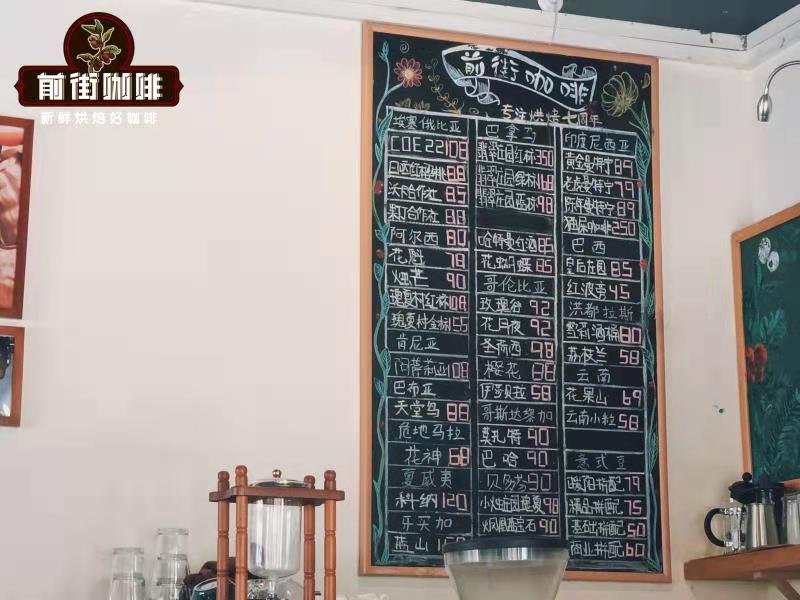Gold standard gold standard geisha coffee beans in Rosa Village, Ethiopia

Professional coffee knowledge exchange more coffee bean information please follow the coffee workshop (Wechat official account cafe_style)
Gold bid batch of geisha coffee beans in Rosa Village, Ethiopia
Introduction to raw beans:
Country: Ethiopia Ethiopia
Production area: Gesha Village, Ruoxia Village
Variety: 100% Geisha
Grade: Nbig A
Altitude: 1900-2100m
Treatment method: 100% red cherry scaffolding sun treatment Natural
Trade description:
Baking degree: shallow baking
Flavor description: after the mouth, sweet egg blossoms and roses, blueberries, wine, grape juice, followed by peach and strawberry aromas, ending with orange peel and orange blossom, strong, delicate and long finish.
Manor background
Adam Overton and Samuel Rachel have been growing Ethiopian Rose Summer in nearly 500 hectares of Rosa Village since 2011, and their sole goal is to produce the best coffee in the world. After three years of searching from 1900 to 2008, they finally found an environmental system suitable for coffee growth in Michael's altitude of 1900-2008, with tropical rain forest, suitable climate, fertile forest soil and long history of forest.
The coffee farm in Ruoxia Village has a total area of 471 hectares, and 300 hectares of coffee has been planted in 2015, with an increase of 50 hectares in 2016. Rosa was selected from the native coffee forest (Gori Gesha), 20 kilometers from the manor, which is where the Panamanian variety came from. With the help of Mr. Willem Boot, the godfather of Rosa, the coffee in Rosa Village has won many good results in the world competition.
Strong traceability and high quality control
Unlike most Ethiopian coffee, it needs to be exported through ECX (Ethiopian Commodity Exchange) or cooperatives. Because of its size of nearly 500 hectares, Ruoxia Village Coffee Manor can be treated and exported independently as a single manor. Therefore, it has traceability unmatched by other Ethiopian raw beans.
Each batch of raw beans can be traced back to its specific plot, variety, tree age, picking date, sun (washing) treatment time and other links, effectively ensuring the transparency of each link and the possibility of quality control.
What is the difference between Gori Gesha and Gesha1931?
Gori Gesha and Gesha 1931 all refer to the name of the variety planted.
Three varieties were planted in Guoxia Village, namely, Gori Gesha, Gesha 1931 and Illubabor Forest. The first two varieties are Rosa rugosa, while Illubabor Forest is a disease-resistant variety provided by the Ethiopian Research Institute.
Among them, Gori Gesha is a rose variety from the wild coffee forest Gori Gesha near the manor, which covers the genetic diversity of Rosa, so it is named after the forest.
Gesha 1931 is selected from several rose summer varieties in Gori Gesha forest, which is closest to Panama rose summer. The selection of varieties depends on the shape of coffee plant, the appearance of coffee beans and the results of cup test. It is also named Gesha 1931 because 1931 was the year in which the rose variety was discovered from Ethiopia.
What do OMA, SURMA, etc. Represent?
The manor is divided into nearly 500 hectares of land according to different varieties and microclimate (as shown in the following figure):
Therefore, the distribution of varieties is as follows:
Planting Gori Gesha: Shewa-Jibabu; Shaya, Bangi
Planting Gesha 1931: Surma; Oma; Narsha
Planting Illubabor Forest: Dimma; Gaylee
What is the meaning of the number in the batch name?
At this time, we should start to talk specifically about the traceability of Rose Xia Village.
Take the sun-drying batches of the OMA plots of Japanese champion Guizhiro Ishitani as an example. The planting variety of the plot is Gesha 1931, and the interior of the plot is divided into five sun batches of 51, 72, 77, 86 and 90. The closer the area is, the closer the maturity and picking period is. In addition, OMA#27 is an one-to-one washing batch for the site. The competition bean of Shigu Gui is a competitive lot of OMA#51, and one of the batches ordered by Grand Cru Coffee is the same batch of OMA#72.
After many cup tests and screening, Grand Cru Coffee selected three distinct sun batches and purchased them in batches, of which the first batch of Surma#85 and Shewa-Jibabu#59 has been sold out; the second batch of replenishment Shewa-Jibabu#59 the same batch, Oma#72 the same batch of spot supply.
The specific cup test flavor is as follows:
1 Shewa-Jibabu#59 same batch (Gori Gesha)
The batch has outstanding sweetness, obvious strawberry, peach, papaya and other flavors, and the flower smell is delicate and the taste is as rich as cream.
2 Oma#72 in the same batch (Gesha 1931)
This batch is sugar-soaked fruit with strong floral aroma and high complexity.
The above two batches of Rosa rugosa were treated by solarization. First remove the floating impurities, and then cover the African-style elevated scaffolding with film and plastic sheet. the total drying time is 18-30 days.
END
Important Notice :
前街咖啡 FrontStreet Coffee has moved to new addredd:
FrontStreet Coffee Address: 315,Donghua East Road,GuangZhou
Tel:020 38364473
- Prev

Panamanian Jade Manor Rose Summer Coffee Variety Story Blue Green Red Standard Rose Summer Coffee Flavor
Panamanian Emerald Manor Esmeralda Manor (PanamaGeishaHaciendaLaEsmeralda) can be said to be the most famous rosy summer, since 2005, Emerald Manor Rose Summer has won more than a dozen world coffee competitions. And the Emerald Manor
- Next

Hawaiian Kona Coffee is the only place in the United States that produces top varieties of coffee.
Professional coffee knowledge exchange more coffee bean information please follow the coffee workshop (Wechat official account cafe_style) Hawaii Kona Coffee Hawaiian Coffee dates back to 1840, the special climate on the slopes of the Kona region on the west coast of the island provides a unique environment for its cultivation. The coffee beans cultivated here have unusually full appearance, bright luster and rich fragrance.
Related
- Detailed explanation of Jadeite planting Land in Panamanian Jadeite Manor introduction to the grading system of Jadeite competitive bidding, Red bid, Green bid and Rose Summer
- Story of Coffee planting in Brenka region of Costa Rica Stonehenge Manor anaerobic heavy honey treatment of flavor mouth
- What's on the barrel of Blue Mountain Coffee beans?
- Can American coffee also pull flowers? How to use hot American style to pull out a good-looking pattern?
- Can you make a cold extract with coffee beans? What is the right proportion for cold-extracted coffee formula?
- Indonesian PWN Gold Mandrine Coffee Origin Features Flavor How to Chong? Mandolin coffee is American.
- A brief introduction to the flavor characteristics of Brazilian yellow bourbon coffee beans
- What is the effect of different water quality on the flavor of cold-extracted coffee? What kind of water is best for brewing coffee?
- Why do you think of Rose Summer whenever you mention Panamanian coffee?
- Introduction to the characteristics of authentic blue mountain coffee bean producing areas? What is the CIB Coffee Authority in Jamaica?

